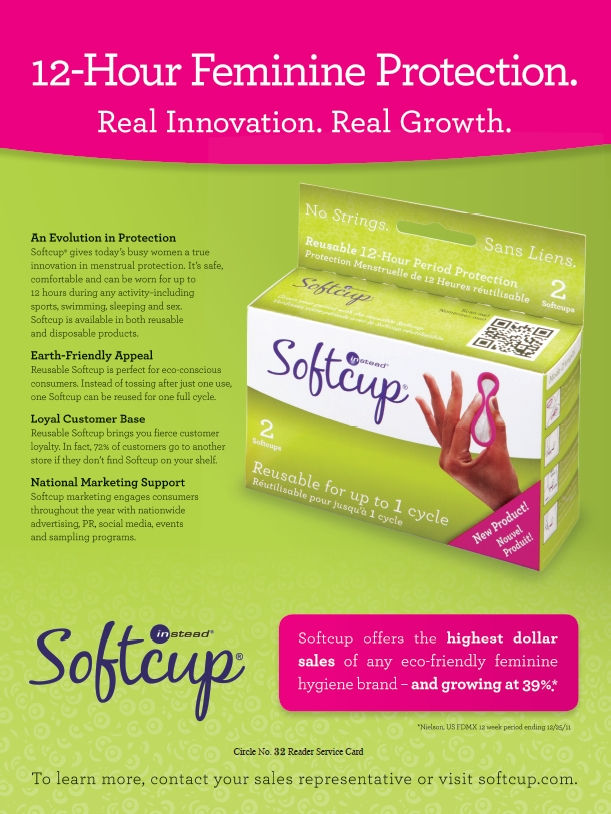When it comes to feminine hygiene, some stores only carry what they feel are the basics: standard throwaway pads and tampons. Savvy shop-owners, however, know there’s much more to monthly protection. Allergies, discomfort and concern over their environmental impact can all affect what women face during their menstrual cycles. Help your female customers have a better time-of-the-month by giving them relief and peace of mind with a broader feminine hygiene section. From disposable eco-friendly basics to reusable innovations, your customers will love being given more natural options.
The Comfort of Cotton
Choosing a disposable tampon or pad seems simple enough, but not all cotton is made equally. U.S. organic cotton is held to strict federal standards for production, processing and distribution that are very different from conventional crops (1). The methods of growing organic cotton have a low impact on the environment and replenish and maintain soil fertility, do not use toxic pesticides or synthetic fertilizers and follow the federal organic regulations against genetically engineered seeds (1). This process results in a chemical- and allergen-free product that women can feel safe using without the possible danger of encountering anything potentially harmful. Organic tampons e ven minimize the risk of toxic-shock syndrome, a condition caused by bacteria associated with the use of synthetic, highly absorbable tampons. In addition, disposables are arguably the most convenient form of monthly protection for most women.
ven minimize the risk of toxic-shock syndrome, a condition caused by bacteria associated with the use of synthetic, highly absorbable tampons. In addition, disposables are arguably the most convenient form of monthly protection for most women.
Although organic cotton does have benefits, disposable protection made organically will still end up in the trash. This goes for tampons that have applicators or soiled pads that women cannot flush. Landfills collect billions of pounds of disposable feminine products a year, specifically 13.5 billion sanitary pads and 6.5 billion tampons in 1998 (2). Within this waste, dangerous pathogens are potentially high, which could possibly leach into the ground and collect in local drinking water, as well as be transported through scavenging animals at landfill sites (3). But women do have options, some that may not only help reduce their environmental impact, but also completely stop their contribution to the billions of pounds of landfill.
Choosing to Reuse
Reusable products have been around since the beginning, before disposables became more of our cultural norm. Women used to wear belts and undergarments with attachments for cloth to be used and washed, then hung out to dry (4). Although this is no longer a common sight, some women prefer reusable products as a way to stay connected to themselves as well as the planet. The first obvious benefit of reusing products is that most products last several cycles. The second benefit is the monetary savings; instead of spending money every month on a box of disposables, a one-time payment could be all it takes for a year of protection, depending on the product. Two of these products are pads and cups.
Washable pads have evolved over the years to include different fillers and designs, with some made to snap on and others that are held in place by elastic (4). Some are made with thick, waterproof liners to compensate for heavier days, and others are thin for lighter cycles. Organic cotton can also be used in creating reusable pads, along with their disposable counterparts, as cotton is comfortably worn and easy to wash (4).
Menstrual cups have an interesting history. In the 1930s, both tampons and cups were introduced to the market to supposedly compete with the popular sanitary napkins of the day (4). The cups were first made of rubber, but quickly fell out of practice due to a rubber shortage during WWII and because the  cups themselves were too heavy and uncomfortable for women to wear (4). It wasn’t until the 1950s when the cup was redesigned by Leona Chalmers did the cup come back into North American use (5). Since then, more innovations and materials have gone into creating a reliable seal and lightweight product. Modern designs are made from materials like silicone instead of rubber, have a pointed end for easy removal and are lighter and foldable for better insertion and cupping of the cervix (5). According to one menstrual cups maker, using the cup method works well for active lifestyles, and can be worn while sleeping, urinating, and for up to 12 hours before needing to be emptied and washed (2). Despite being a mostly reusable product, there is at least one cup on the market that is meant to have the same benefits, but thrown away and replaced after one cycle.
cups themselves were too heavy and uncomfortable for women to wear (4). It wasn’t until the 1950s when the cup was redesigned by Leona Chalmers did the cup come back into North American use (5). Since then, more innovations and materials have gone into creating a reliable seal and lightweight product. Modern designs are made from materials like silicone instead of rubber, have a pointed end for easy removal and are lighter and foldable for better insertion and cupping of the cervix (5). According to one menstrual cups maker, using the cup method works well for active lifestyles, and can be worn while sleeping, urinating, and for up to 12 hours before needing to be emptied and washed (2). Despite being a mostly reusable product, there is at least one cup on the market that is meant to have the same benefits, but thrown away and replaced after one cycle.
Some women are not comfortable with the idea of reusing an intimate product, while others embrace the notion. It may help for potential buyers to know that cleaning a pad can be as easy as throwing it in the washing machine. Companies do create special bags for storage of soiled pads when users are away from home, and some companies that make cups also make specially designed washes, although cups should always be boiled at the end of each cycle to maintain sterility (2). Keep the reusable items, bags and washes together so customers can easily grab everything they need at once for a worry-free cycle.
Something for Every Woman
Your customers will have different preferences, concerns and needs for their menstrual cycles; being well-versed in all of the benefits and pitfalls of feminine hygiene will help enhance your sales as well as the lives of your female customers. WF
References
1. “Organic Cotton Facts,” www.ota.com/organic/mt/organic_cotton.html, accessed Feb. 22, 2012.
2. Press material supplied by Diva International.
3. R. Taylor and A. Allen, “Waste Disposal and Landfill: Information Needs,” www.who.int/water_sanitation_health/resourcesquality/en/groundwater12.pdf, accessed Feb. 22, 2012.
4. “Washable Pads,” www.mum.org/collectionwash.htm, accessed Feb. 22, 2012.
5. “Menstrual Cups 1,” www.mum.org/CupPat1.htm, accessed Feb. 22, 2012.
Published in WholeFoods Magazine, April 2012









